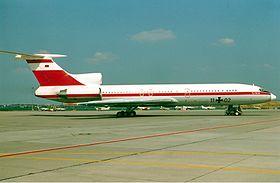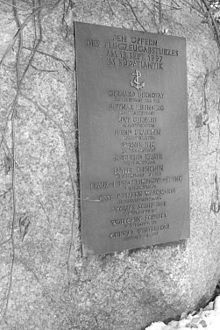Airplane collision off Namibia in 1997
| Airplane collision off Namibia in 1997 | |
|---|---|
|
The crashed Tu-154M in 1993 in Stuttgart |
|
| Accident summary | |
| Accident type | Airplane collision in the air |
| place | Atlantic Ocean , off the coast of Namibia |
| date | September 13, 1997 |
| Fatalities | 33 |
| 1. Aircraft | |
| Aircraft type | Tupolev Tu-154 |
| operator |
|
| Mark | 11 + 02 |
| Departure airport |
|
| Stopover |
|
| Destination airport |
|
| Passengers | 14th |
| crew | 10 |
| Survivors | no |
| 2. Aircraft | |
| Aircraft type | Lockheed C-141 Starlifter |
| operator |
|
| Mark | 65-9405 |
| Departure airport |
|
| Destination airport |
|
| crew | 9 |
| Survivors | no |
| Lists of aviation accidents | |
Approximate crash location in the Atlantic and position of Windhoek Airport, start location of the C-141 and planned next stopover of the Tu-154 |
The aircraft collision off Namibia in 1997 occurred on September 13, 1997 over the Atlantic off the South African state of Namibia between a Tupolev Tu-154 of the readiness for flight of the Federal Ministry of Defense and an American military transporter of the Lockheed C-141 Starlifter type . All occupants of both aircraft were killed in the collision .
The reasons for the collision were an incorrectly chosen flight level of the Tupolev against the semicircular flight altitudes as well as a lack of or nonexistent air traffic control in the affected area, which means that no air traffic controller made the crew of the German aircraft aware of their mistake.
Aircraft
Tupolev Tu-154
The aircraft had been used in the Transport Fliegergeschwader 44 (TG-44) of the National People's Army of the GDR and, with the end of the GDR, came into the possession of the Federal Republic and thus the holdings of the Air Force of the German Armed Forces, +02) as well as a sister aircraft of the same type (11 + 01) to continue to operate and to be used for passenger transport and flights under the Open Skies contract . The aircraft involved in the accident was already equipped with the sensors for such flights, and its sister aircraft was to be upgraded a short time later.
crew
The flight's cockpit crew was considered highly experienced. The pilots had been transferred from the TG-44 of the Air Force of the National People's Army to the Bundeswehr and had all flown at least 1000 flight hours on the Tupolew Tu-154, the commander Ralph Reinhold (a son of Wolfgang Reinhold ) had a total of 7369 hours , the co-pilot on 3947 hours; All crew members had also carried out flights through the poorly controlled African airspace with the corresponding requirements.
Flight order
In addition to the ten-man crew, there were two wives on board the machine, 12 members of the Navy , who were to take part in a regatta for the 75th anniversary of the naval forces in Cape Town at the invitation of the South African Navy , as well as a technician from Elbe Flugzeugwerke who the Open Skies electronics flew with it.
Lockheed C-141 Starlifter
The second aircraft involved was a Lockheed C-141 Starlifter with the registration number 65-9405 and the radio call sign Reach 4201 ("Reach" is the call sign of all aircraft that are underway on behalf of the Air Mobility Command ).
procedure
The German Tupolev took off from the headquarters of the flight readiness at Cologne / Bonn Airport and landed at Niamey Airport in Niger to refuel . She was supposed to land again in Windhoek before reaching Cape Town. The US Air Force starlifter took off from the Namibian capital and was supposed to fly to Ascension Island .
The German aircraft had specified flight level 390 (39,000 ft (11,887 m)) as cruising altitude in the flight plan and was flying at flight level 350, i.e. 35,000 ft (10,668 m) on the corresponding route at the time of the accident, but had no radio contact with an air traffic control unit . Due to the inadequate radar coverage in the Central African countries, aircraft routinely broadcast position reports in the corresponding areas so that other aircraft on the same frequency can get an idea of the rest of the air traffic. Tupolev's flight plan was available both in Luanda (the responsible air traffic control in Windhoek) and in Windhoek itself, but the controllers in Luanda could only contact the German crew once on a shortwave frequency.
Reach 4201 had also risen to FL350 after take-off and was in contact with air traffic control in Windhoek. The American plane was on the Windhoek frequency until the crash. None of the controllers involved noticed the flight altitude deviating from the flight plan, which is why both aircraft collided at around 3:10 p.m. UTC. The wreckage of the aircraft fell into the sea about 120 kilometers off the coast of Namibia, there were no survivors.
causes
The cause of the accident was determined to be that the German Tupolev was flying at the wrong altitude. The so-called semicircular flight altitudes are selected according to the magnetic course, whereby aircraft with a magnetic course of 0 ° –179 ° choose an odd flight altitude (FL230, FL250 etc.), with a magnetic course of 180 ° –360 ° one becomes even If the flight level is selected (FL220, FL240, etc.), a vertical separation of at least 1000 feet is guaranteed at all times if aircraft are approaching each other at a corresponding speed. Above flight level 290, the staggering is even 2000 feet, so the Tupolev would have had to fly at FL330 or FL370 - however, neither the crew nor the air traffic controllers noticed the error in the flight plan. The Starlifter was flying correctly at FL350, it could also have flown at FL390.
In addition, none of the machines was equipped with a Traffic Alert and Collision Avoidance System (TCAS) that would have displayed one machine in the cockpit of the other; Scaffolding in the Tupolev was planned, but not yet implemented at the time of the accident.
The poor radar coverage in Africa in general and the behavior of the pilots in Luanda in particular are considered contributing causes. They had lost contact with GAF 074 and could not give the crew any direct instructions; but they did not try to control the aircraft from another air traffic control, e.g. B. Windhoek to reach. The pilots also did not notice that the aircraft was flying at an incorrect altitude.
consequences
The political-parliamentary educational work dealt primarily with the question of why the Tupolev was neither equipped with a TCAS nor a flight data recorder. According to Focus , the ready-to- fly machines were being converted , but only the Airbus A310 and Bombardier Challenger short-haul jets used for VIP transport had been converted up to the time of the accident . The Tupolev Tu-154 should have been equipped with the device at the end of 1997. Because there was no “ flight recorder ”, the cause of the accident could never be clarified beyond doubt.
The planned retrofitting of the sister aircraft, the machine with the registration number 11 + 01, to an open skies system carrier was shelved after the collision and the model was removed from the flight readiness fleet.
See also
- Lockheed Accident Report C-141B 65-9405 , Aviation Safety Network , accessed December 11, 2018.
Individual evidence
- ↑ No money for security . In: Der Spiegel . No. 39 , 1997, pp. 34-38 ( Online - Mar. 20, 1997 ).
- ^ Rüdiger Moniac: German pilot caused a collision. In: The world . April 1, 1998, accessed August 20, 2015 .
- ↑ Collision caused a plane crash. In: Rhein-Zeitung . September 17, 1997, accessed August 20, 2015 .
- ↑ Gudrun Dometeit, Peter Gruber, Peter Hintze, Axel Hofmann, Michael Jach, Frank Räther, Günter upsetting: Death Flight GAF 07 4. In: Focus . September 22, 1997, accessed August 20, 2015 .
- ↑ Sascha Jonak: Memorial ceremony on the high seas and farewell to the father. In: Marine.de. Bundeswehr, March 2, 2015, accessed on August 20, 2015 .
- ↑ a b c d e f Accident Report C-141B 65-9405 , Aviation Safety Network (English), accessed on December 11, 2018.
- ↑ Error by the Bundeswehr pilot, cause of Tupolev crash. In: tagesspiegel.de. Der Tagesspiegel , March 31, 1998, accessed on August 20, 2015 .
Coordinates: 20 ° 12 ′ 0 ″ S , 12 ° 0 ′ 0 ″ E


